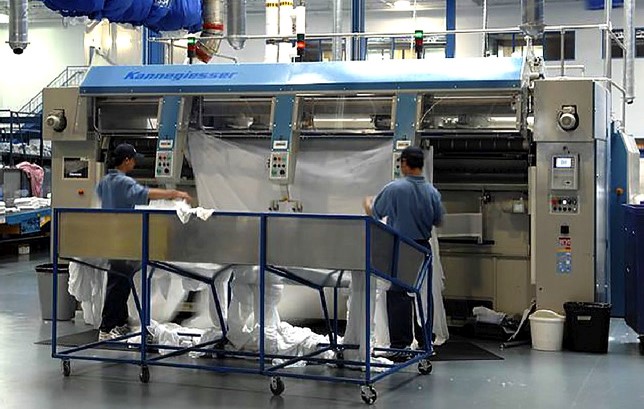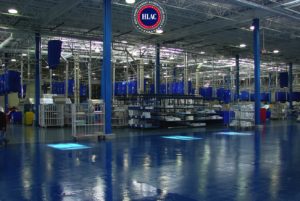
Note: This is one of a four-article series (links below) originally published in Infection Control Today and sponsored by the Healthcare Laundry Accreditation Council (HLAC). Reprinted with permission of HLAC.
By Gregory Gicewicz and Janice Carter Larson
In matters concerning healthcare textiles (HCTs), the focus of most infection preventionists (IPs) has logically been related to the implementation of infection prevention strategy. But is that enough anymore? The fact is, in this age of dwindling resources and funding, developing an effective linen strategy can give IPs plenty of opportunities to demonstrate positive, measurable bottom-line value and thereby increase their influence over relevant policy and decision making.
Success depends on the choices one makes in administering this strategy and this begins with having an understanding of the end-to-end linen and laundry value proposition, regardless of whether a hospital has an on-premise laundry or outsources its laundry service. Quite simply, the more IPs understand where the value lies, the more influence they’ll have, and the greater the bottom-line impact.
Here are some key considerations where the knowledgeable IP can make a difference.
Linen Vendor Choice
If a hospital outsources its linen processing, choosing the best vendor is a critical financial decision. It can be a temptation to choose the linen vendor solely on the offered price-per-clean pound of delivered laundry. But this approach is beset with risks.
Today, leading hospitals are requiring in their RFPs that commercial laundries and cooperatives have accreditation from the Healthcare Laundry Accreditation Council (HLAC). That is, healthcare customers and potential customers want formal acknowledgement from the laundry verifying that its processes are based on the highest professionally recognized standards. This same HLAC accreditation is also available to on-premise laundries.
The potential risks to a hospital of using a laundry not following the highest standards of infection prevention can far outweigh any perceived savings in linen cost per pound. While documented cases of HCTs contributing to healthcare-associated infections (HAIs) and deaths are rare, reports of microorganisms on HCTs as a source of infections is possible, and can threaten not only patients and staff, but also a facility’s reputation and finances.
Linen Choices
Hospitals that provide superior patient experience generate 50 percent higher financial performance than an average provider. With this fact in mind, when it comes to linen strategy, healthcare could learn a thing or two from the hospitality industry, where guests have come to expect premium linens from leading hotels. In fact, luxurious bedding and linens are among the most important amenities a hotel can offer, according to a recent guest satisfaction survey. There’s no denying that plush, hotel-style linens are expensive; but if they help to make for a positive patient experience, it may be worth it.
Here are some other linen-related choices that, with proper understanding, can impact the bottom line:
Synthetic, cotton or blended textile: Synthetic healthcare textiles are usually more expensive to purchase. Or are they? Synthetic HCTs will usually last for more processing turns and therefore may actually have a lower cost per use. For example, a $4.50 sheet that lasts 100 turns cost 4.5 cents per use. A less expensive, $3.50 sheet that wears out after 50 turns, costs 7 cents per use, or 56 percent more.
In addition, most synthetic HCTs will require less dry time/temperature or ironing temperature. Cotton scrubs will typically take about 15 minutes to dry in atumbler. Newer synthetic scrubs can dry in under 5 minutes. Therefore, there will be an additional net savings in utility costs and production costs.
Linen weights: Most laundry vendors charge by the pound. Therefore, lighter HCTs that provide the same function can provide better overall value. Does the hospital spread blanket need to weigh 3.75 pounds or would a 3-pound blanket work just as well? Will a 1.5-pound bath blanket perform the same for a hospital as a 1.75-pound bath blanket?
Are extra-large bath towels necessary? The heavier, plusher HCT may positively impact patient satisfaction and that is a good thing. But heavier items can also add up in laundry processing costs. Be cautious of the tradeoffs and choose strategically.
What does price per pound actually mean? Many laundry vendors will quote an attractive laundry price per pound but hide the real price behind lots of hidden fees.
It is important to understand the true cost per pound once the hidden fees are factored in. Then do an “apples-to-apples comparison.” Some typical add-on fees to beware of include scrub surcharges, baby item surcharges, loss/damage charges, specialty-item fees, fuel surcharges, minimum delivery fees, stocking fees, and par level fees.
Low temperature chemicals: Laundry chemical vendors have come out with many chemicals that clean at lower temperatures. This will save money on heat used by the laundry. They will also save on linen life, regardless of choice, as linens will last longer.
A low-temperature laundry bleach that activates at 140 degrees Fahrenheit vs. normal hydrogen peroxide, which activates at greater than 180 degrees Fahrenheit, will save significant money in natural gas costs. Furthermore, linens processed by this laundry will last longer since excessive heat shortens linen life. And it should be noted that low temperature chemicals can impact linen costs, yet be as effective in producing hygienically clean textiles.
Disposable vs. reusable: No doubt, IPs often hear among healthcare facilities managers’ arguments in favor of disposable products over reusable HCT products, like infection prevention wipers and mops, sheets, towels, incontinence pads, gowns, mammograms capes, surgical gowns and drapes, etc.
There exists a common belief that disposables are preferable – that they’re less expensive. The truth is, in a typical lifecycle they can be just the opposite – they’re costlier than reusables quite simply because they’re only used once. Also, they’re costlier because of frequency of purchase, their disposal as a biohazard waste, the harm they cause the environment, and the many dangers their use can pose in the healthcare environment, including even the spread of superbugs. Lastly, one cannot control the efficacy or sanitary nature of the disposable; on the other hand, the quality of HCTs is virtually assured when hospitals work in partnership with HLAC-accredited laundries.
Linen Care
Hospital linen-care practices have a large impact on linen and laundry costs, and the IP nurse can play a significant role in raising awareness of this. Did you know that less than 50 percent of hospital linens reach their useful life? The rest are either damaged by preventable abuses, such as tape and adhesives on linen, ink, cutting or tearing, and using linens intended for patient care on environmental cleaning. Many are also lost due to theft, both deliberate and inadvertent.
Operating room (OR) scrubs that are taken out of the hospital setting and not returned must be replaced. Even if the scrubs are returned laundered, the recommendation that surgical attire not be home laundered is supported by clinical evidence. Impacting how and where scrubs are used, and helping to enforce the OR scrub policy, can help save a hospital money.
IPs can also influence policies that prevent non-linen items from ending up in the laundry. Non- linen items thrown into a laundry hamper are expensive problems for the laundry and ultimately the hospital. Garbage, food, papers, and plastics that must be separated during soiled linen sorting are annoying, time consuming and expensive, but relatively harmless. Pharmaceuticals, vials, needles, and other sharps are not only expensive but dangerous for laundry workers and routinely cause workplace injuries, the cost of which is eventually passed on to the end user.
Linen Management
 IPs can play a key role in linen management by being an active member of their hospital’s linen committee or linen task force and by serving as an advocate for good linen practices by clinical staff. Educating clinicians on the necessity of keeping linen covered (both clean and soiled), for example, and bringing only that which is required into patient rooms, and following a “needs based” approach to bed make up can underscore their importance to clinical outcomes.
IPs can play a key role in linen management by being an active member of their hospital’s linen committee or linen task force and by serving as an advocate for good linen practices by clinical staff. Educating clinicians on the necessity of keeping linen covered (both clean and soiled), for example, and bringing only that which is required into patient rooms, and following a “needs based” approach to bed make up can underscore their importance to clinical outcomes.
Adhering to good linen practices at the department level may be viewed as somewhat of an inconvenience to nursing, but not doing so may have serious consequences to patients. Linen stored unprotected runs the risk of contamination, potentially invisible to the naked eye. Extraneous linen in patient rooms may be handled by visitors with questionable hand hygiene. Changing linen items based on a rote schedule rather than a clinical need contradicts the philosophy of patient-centered care.
Although reusable, healthcare linen needs to be managed statistically, just like other consumable medical supplies. The consistent use of linen management software will facilitate data driven decisions about department par levels quantities rather than those made on nursing perceptions of usage. Enlisting IP support for reasonable par levels based on actual usage can eliminate dead stock and the infamous “smorgasbord” effect, i.e., staff using more linen than is necessary for patient care based on over-abundant shelf quantities.
By adhering to best practices in linen management and making it part of overall linen strategy, the hospital can lower the quantity of linen used per adjusted patient day; this can result in a huge financial savings for the hospital. The hospital that consumes, for example 12 pounds of linen per adjusted patient day through best linen in management practices, versus the hospital that consumes 18 pounds of linen per adjusted patient day, will end up saving thousands of dollars over the year even though the price per pound processed they pay is the same. Here’s another way to look at the same scenario:
HOSPITAL A:
- Is charged 50 cents per pound by the laundry (fixed)
- 125,000 adjusted patient days per year (fixed)
- 18 pounds per adjusted patient day
- = 2.25 million pounds per year, which comes to
- $1.125 million per year spent on linen/laundry
HOSPITAL B:
- Is charged 50 cents per pound by the laundry (fixed)
- 125,000 adjusted patient days per year (fixed)
- 12 pounds per adjusted patient day
- = 1.5 million pounds per ye ar, which comes to
- $750,000 per spent on linen/laundry
- or 33 percent savings over HOSPITAL A
Trusted Partnership with Healthcare Laundry
IPs looking for a reliable partner to develop or enhance their linen strategy need look no further than to their healthcare laundry professional. This is especially true if the laundry is HLAC-accredited.
A good practice is for the hospital-based infection prevention team members to treat their healthcare laundry professionals as part of their extended team, where there’s an ongoing sharing of updates in infection control and prevention efforts and in the regulatory and licensing arenas. Important to this team-style relationship is for the IP to visit the healthcare laundry to become acquainted with the personnel responsible for administering the laundry. In fact, the laundry should be open to at least yearly visits from their IPs. These visits are more productive when they’re treated collaboratively.
Critical here is open communication, cooperation and collaboration between the healthcare IP and the laundry profession, “a sharing of knowledge and operational details.” With such collaboration, “a bond can be established that allows both entities to address ongoing issues with desired outcomes.” And, clearly, with an effective healthcare linen strategy, this can also include desired outcomes like measurable, bottom-line value.
About the Authors
Gregory Gicewicz is past-president of HLAC and owner/operator of the healthcare laundry Sterile Surgical Systems in Tumwater, Wash.
Janice Carter Larson, CLLM, is vice president of clinical resources and consulting for Encompass Group LLC. She currently sits on the Association of Linen Management (ALM) board of directors.
Note: This four-article series was originally published in Infection Control Today and sponsored by the Healthcare Laundry Accreditation Council (HLAC). Reprinted with permission of HLAC. Links to all articles are below.
Article 1: Navigating the Intersection Where Healthcare Laundry and Infection Prevention Meet
Article 2: The Importance of Maintaining Quality of Laundered HCTs Prior to Use
Article 3: How IPs Affect a Hospital’s Bottom-Line with Effective Linen Strategy
Article 4: Aligning the IP’s Linen/Laundry Message with the C-Suite Mindset: Key Messages for a Key Messenger














